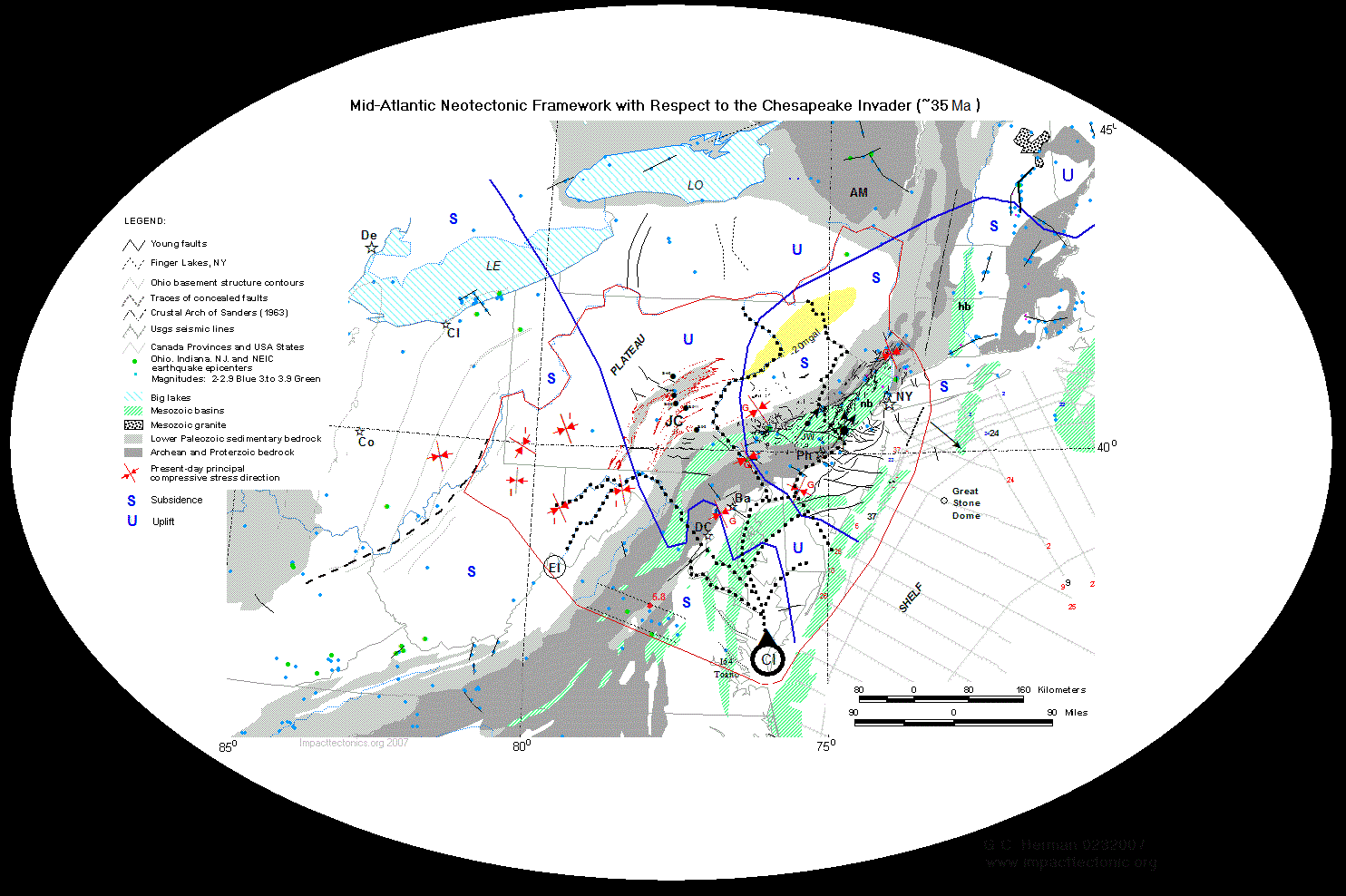Download the New Jersey region KMLZs/2015 Chesapeake Invader Virginia USA.kmz (3.5 MB) Rev. 10/2020;05/2017
A hypervelocity bolide of about 3-5 km diameter indented the Chesapeake Bay about 35 million-years ago. The impact probably directed a tectonic push and lithospheric contraction northward along the bolide's flight path, assumed to be obliquely inclined to the Earth's surface along the axis of Chesapeake Bay as illustrated below. The strain field stemming from the impact is centered on the Pennsylvania Salient, including the Juniata Culmination (JC). The field is wedge shaped and includes three major river courses radiating outward from the point of impact toward the foreland, cutting through crustal strata along zigzagged paths that mimic currently rising and subsiding regions. It's possible that this produced rapid, regional uplift with impact-generated fractures, folds, and faults. The river courses have developed along paths of dense fracturing with uplift of foreland areas beginning in the Late Eocene. Nearby oceanic margin deposits now include a regional Oligocene unconformity topped by Miocene age and younger strata.

The Potomac, Susquehanna, and Delaware river systems continue to feed the continental shelf today. Post Newark compressional strains occur throughout the region that are incongruent with neotectonic structures (Herman, 2015). Moreover, Wise (2004) has demonstrated how late-stage extension fractures (joints) fan out laterally across the culmination in Paleozoic rocks., and Naiser and others (2001) report that major east-flowing Mid-Atlantic rivers did not breach the Blue Ridge until early or middle Miocene time. Impact-related fractures therefore may have formed within a contracted lithospheric wedge lying foreland of the impact crater and above deep-seated, crustal block faults that may have readjusted, or perhaps formed in direct response to impact stresses. Eocene igneous rocks occur along the southern margin of the proposed wedge near the upper reaches of the Potomac river near a linear swarm of historical seismicity. Crustal isotopic data from sulfide-mineralized fault breccia through the foreland wedge not only date back to the event, but have crustal concentrations indicating impact-related fractures penetrated to mantle depths. A pronounced, closed gravity anomaly (yellow) occupies a congruent position on the other side of the culmination to the NE. It therefore appears that the Chesapeake Invader (Poag, 1999) helped shape today's regional landscape and current neotectonic setting of the mid-Atlantic foreland region.
Screen capture of a GE display showing the Chesapeake impact crater with respect to the resulting crustal blast pattern, regional basement structure contours (feet) atop Precambrian basement (Rickard , 1973; Baranoski, 2013), CAMP dolerite dikes (Herman and others, 2015) deep basement faults of the Rome trough (deWitt, 1993), and linear traces of strong aeromagnetic positive amomolies seen in the global potential field data of Maus and others (2017). Crustal-compaction values gained from calcite-strain-guage data by Engelder (1979), Spang and Groshong (1981), Lomando and Engelder (1984), Craddock and others (1993), and Ong and others (2007). Green circles trace approximate crestlines of lithospheric arches lying circumferential to the crater shown at 300 and 760 kilometers radius from the crater that bracket interening troughs represented in profile in figure 6. The Westminster arch (Campbell, 1929) is highlighted using yellow structural contours and a red, doubly plunging crestline. This arch affects only lowest Tertiary gravels laid down prior to impact.